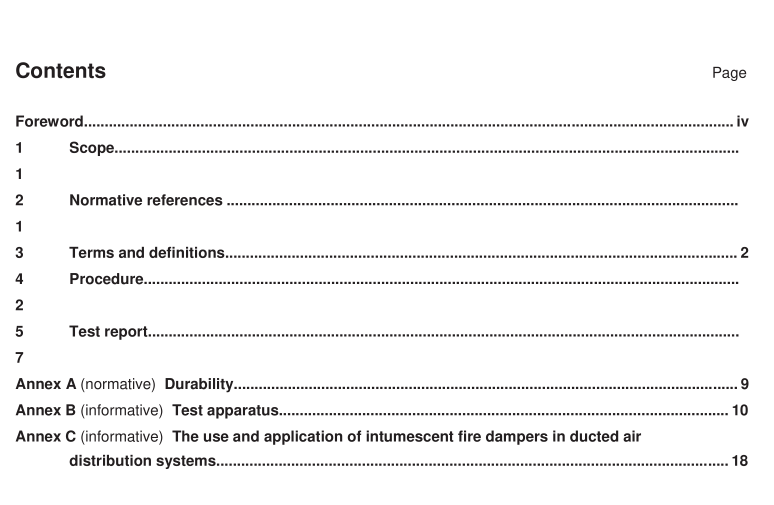BS ISO 10294-5 pdf download

BS ISO 10294-5 pdf download Fire resistance tests — Fire dampers for air distribution systems — Part 5: Intumescent fire dampers
4.1.3 Test procedure
4.1.3.1 General procedure and criteria
Other than the exceptions stated below, carry out the test in accordance with lSO 10294-1.The criteria withrespect to integrity and insulation shall be as specified in ISO 10294-2.
4.1.3.1.1Opening and closing cycles
The 50 opening and closing cycles specified are not applicable to this product.
NOTE The reason for the 50-cycle test for mechanical dampers is to demonstrate the likelihood of their functioningwhen called upon to do so,without jamming or disintegrating. Clearly a product that is activated by an irreversiblechemical activity cannot be activated more than once. There are no parts moving mechanically in an intumescent firedamper, only the swelling of the intumescent material when activated by heat.
4.1.3.1.2Time to close
There is no requirement for the damper to close before 2 min, but it shall satisfy leakage requirements after5 min into the test.
NOTE The 2 min limit in the test for mechanical dampers is the time beyond which it is deemed that dampers thathave not closed will not do so; therefore, contiruation of the test would be irrelevant. Since the time deemed necessary forthe furnace to stabilize is 5 min and no sensor values are considered accurate enough to record until that time haselapsed, the 2 min period has no relevance in the case of intumescent dampers.
4.1.3.1.3Condensing device
A suitable condensing device may be considered to be a water tank fed with water at ambient temperaturewith about 9 m of measuring duct immersed in the tank prior to reaching the measuring device.
4.2Reaction to fire tests – Intumescent materials
4.2.1General
To ensure some equivalence with a mechanical damper,the following tests are described that allow anassessment of the reliability of intumescent materials used for intumescent fire dampers. These tests can beused as an initial type test to get the performance of an intumescent material tested. The result is normallyused to define the specification for the material. In this case 10 specimens shall normally be tested.For thepurpose of factory control, two specimens are normally used to show compliance with the specification.
Thermal activation and faulty set-off are normally tested only in the course of the initial type test but all threealternatives for “expansion pressure” are suitable tests for factory control.
Expansion pressure is normally determined at various temperatures during the initial type test to find out therange of minimum temperature dependence. For the purposes of factory production control these tests arenormally conducted at a temperature in the range of temperature independence to ensure that the effect oftemperature variation on the results is minimized.
Complete components or sections of components of the damper, in sufficient quantity to complete the rangeof testing required by the test authority and manufacturer, shall be nominated as representative specimens forinitial type testing and all subsequent production control conformity tests, as dictated by localcertification/approval needs.
Sample sets shall be placed in ambient laboratory conditions consisting of a temperature of 23 °C± 4 °C anda humidity of 50 % for a minimum of seven days.
4.2.2 Thermal activation temperature test
4.2.2.1 General
This test is used to assess the activation temperature of the intumescent material used in the damper.
4.2.2.2 Apparatus
4.2.2.2.1 Oven, with an operating temperature range of 25 °C to 350 °C to within better than ± 3 °C.
4.2.2.2.2 Temperature-measuring and display device for the oven, with an accuracy of ± 1 °C.
4.2.2.3 Test specimens
Three specimens of the smallest-sized damper in the range of critical reactive intumescent components shall be tested.
4.2.2.4 Test method Each specimen or critical reactive component shall be placed in the oven. The oven shall be set at 30 °C below the activation temperature given by the manufacturer for the intumescent material under test. The oven temperature shall be maintained for at least 1 5 min and intumescent activity observed. Should no intumescent development occur, the temperature shall be increased by increments of 5 °C and maintained for a minimum of 1 5 min at each stage until activation does commence.
4.2.3 Faulty set-off
4.2.3.1 General This test method is intended to cover standard operating conditions (60 °C; see ISO 1 0294-4). However, the test method may be adapted to cover situations where the intumescent damper is intended to be operated at either lower or higher temperatures, for example dampers used in cold climates or those installed in warm-air ducts, by using the appropriate operating temperature as the test temperature. Except for the temperatures/threshold limits, there shall be accordance with all other conditions specified in this part of ISO 1 0294.









